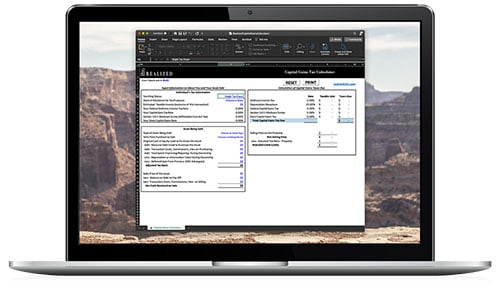
With the holidays and celebrations in the rear-view mirror, your attention should turn to the next big event. Not Valentine’s Day or St. Patrick’s Day, but April 15, the tax-filing date. Even as you gather paperwork and finalize profits, losses, and expenses from 2019, it’s important to pay extra attention to your asset sales. In most cases, you’ll be required to report capital gains from those sales to the IRS through three forms: 8948, 1099-B, and Schedule D.
This blog will help clarify the purpose of these forms, and how to use them. However, a good way to understand the capital gains reporting process is to define some of the most-used terms.
Knowing Your Terminology
Assets are defined as anything of value that can be converted into cash, mostly through sales. Going further, assets are divided into two categories. Tangible assets (stocks, certificates, gold, coins, real estate) are, for the most part, those you can see, whereas intangible assets (copyrights, intellectual property, patents) can’t be seen or touched. This blog focuses on capital gains from the sale of tangible assets.
Capital gains represent the difference between what you paid to acquire the asset (known as the “basis”), and the cash received upon the asset’s sale. Furthermore, the length of time during which you hold on to the asset determines how much you pay in capital gains taxes. Specifically:
- If you owned the asset for less than one year (short-term hold), your capital gains will be taxed at a higher rate, as ordinary income.
- If owned the asset for at least one year or longer (long-term hold), your capital gains will be taxed at a lower rate.
If the sale resulted in a loss, you would not be taxed in most cases. Whether your asset sale results in a profit or loss, however, the IRS wants to know about it.
Form 8949: The “Root” of Capital Gains Reporting
Form 8949 is officially called “Sales and Other Dispositions of Capital Assets.” Before 2011, Form 8949 didn’t exist. Instead, gains and losses of asset sales were reported directly on Schedule D. These days the IRS wants more detail, which is provided on the 8949. Such information should include the following.
- The sale or exchange of a capital asset that isn’t reported on another form or schedule.
- Gains from involuntary conversions, other than occurrence from casualty or theft. Involuntary conversions occur when a property is destroyed, stolen, condemned, or disposed of, under the threat of condemnation.
- Non-business bad debts.
- An election to defer capital gains invested in a Qualified Opportunity Fund (QOF), or disposition of interests in QOFs.
Information required on the 8949 includes the type of asset sold, the acquisition and disposition dates, and the basis and sales price. This form is a two-page affair; one page details the sale of long-term-held assets, while the other focuses on assets held over the short term.
You don’t need to complete a Form 8949, as long as you:
- Attach a separate statement, with transaction details, in a format that meets the IRS reporting requirements,
- Receive a Form 1099-B, meaning your broker already reported the cost basis and asset sale information to the IRS, or
- Don’t have a nondeductible wash sale loss or adjustment to the basis (gain or loss).
A wash sale occurs if you sell or trade an asset at a loss and then, within 30 days before or after the sale, acquire a “substantially identical” asset. There isn’t a problem with this, as long as you don’t deduct a capital loss on the sale, and put it against any gain you might realize.
Speaking of brokers . . .
Form 1099-B: Your Broker’s Information
Your broker is responsible for filling out the Form 1099-B, also known as “Proceeds from Broker and Barter Exchange.” Your broker is also required to submit this form to the IRS, and to mail a copy to you by January 31 of the year following the previous tax year. You’ll need information from this form (as well as the Form 8949) to complete a Schedule D.
Similar to the 8949, the 1099-B describes each investment sale, including asset types, purchase/sale dates and prices, and resulting gain or loss, excluding commissions. Because this form (with the cost basis) will already be submitted to the IRS, you won’t need to repeat the information on the 8949.
Summarizing it All on Schedule D
Schedule D is where you summarize the information from the 1099-B and 8949, transferring the cost basis, sales prices, and any capital gains or losses. This information is combined with income or loss from other forms or schedules, with the result ending up on Line 44 of your 1040. Basically, the Schedule D information impacts your adjusted gross income.
In Conclusion
The key to your asset sale and capital gains reporting is that the IRS wants to know about it through the following methods:
- On a Form 8949 and/or Form 1099-B
- On a Schedule D, summarizing information from Form 8949, Form 1099-B, and other schedules or forms.
While the above is a basic overview of how to report your capital gains or losses, your best bet is to turn to your CPA, accountant, or financial advisor. These professionals make it their business to keep up-to-date on the latest trends, and have the knowledge to ensure correct reporting.
This material is for general information and educational purposes only. Information is based on data gathered from what we believe are reliable sources. It is not guaranteed as to accuracy, does not purport to be complete and is not intended to be used as a primary basis for investment decisions. It should also not be construed as advice meeting the particular investment needs of any investor.
Realized does not offer legal or tax advice. As such, this information should not be used as a substitute for consultation with professional accounting, tax, legal or other competent advisers. Before making any decision or taking any action, you should consult with a qualified professional.


